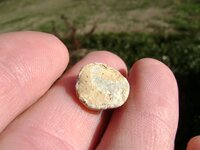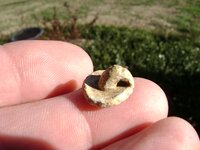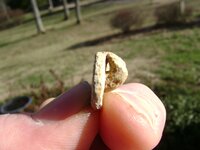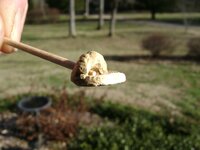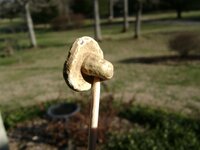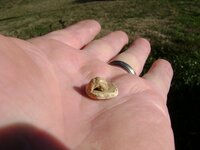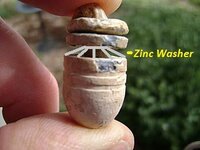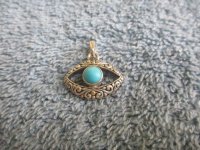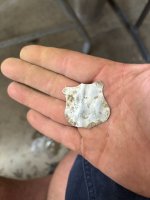You are using an out of date browser. It may not display this or other websites correctly.
You should upgrade or use an alternative browser.
You should upgrade or use an alternative browser.
ZINC BUTTON
- Thread starter got2dig
- Start date
VOL1266-X
Gold Member
- Jan 10, 2007
- 5,589
- 2,909
- Detector(s) used
- Fisher 1266-X, F75 X 2
- Primary Interest:
- Relic Hunting
Since one cleaner bullet came with a pack of 20 "factory" bullets with pre-measured powder wrapped in paper and tied to the bullet with a string, we don't dig that many cleaners in the early war (1862) sites in the Western theater of the war. Soldier's diaries indicate that many cleaner bullets were discarded simply because the washer expanded quickly creating a tight bore fit and made the gun kick really bad. As with ramrods, I feel certain that men were killed by Williams Cleaner bullets in the heat of battle. HH, Quindy.
Amazon Forum Fav 👍
Last edited:
got2dig
Bronze Member
- Thread starter
- #22
The cleaner bullets were entirely designed and manufactured specifically to clean the bore on muzzle-loading rifles (rather than simply an insert for a standard bullet). The main nose section of a Williams Patent Cleaner bullet, is molded of lead with a hollow shaft hole at the base. There is then a bottom base of lead also or pin with a shaft (depending on the variety of Williams Cleaner bullet), that is designed to fit in the base of that specially designed bullet body. The zinc portion, is a thin washer, that is slightly convex, fitting in the gap between the bullet nose and inserted base. Upon firing, the base and shaft portion of the bullet is pushed up against the main nose portion, whereby the zinc washer is expanded outward, to assist in cleaning the bore of the rifle. Since the zinc washer portion is very thin, and considering that zinc does not withstand the elements of exposure in most ground conditions, accounts for few Williams Cleaner bullets being found with intact zinc washer portions.
The possible field-made "button" shown above, which is likely the base of a type II Williams Cleaner bullet, is in fact lead alloy and not zinc. The zinc portion would have been a very thin washer type piece, fitting on the shaft (now bent over). The zinc washer would have been larger diameter than the lead base of the bullet, yet the convex shape of the washer when manufactured, would keep the actual diameter flush with the bullet, until firing compressed and expanded the zinc washer. The length of the bent over shaft on the excavated example, of possible use as a "button", seems longer than what I've seen on the more commonly encountered Type III Williams Cleaner bullets. My hunch leans towards the Type II base as origin. The Type III was basically the same design, with a shorter nose and body section having two rings, opposed to the longer three ring version seem in Type II bullets.
Since Williams Cleaner bullets were prone to mishaps such as jamming when fired, experienced soldiers were soon removing the cleaner bullets from the cartridge packages prior to and during battle (originally 1 cleaner bullet was included with 9 standard rounds in a package, later increased during the war to include additional cleaner rounds). At one battlefield site in Tennessee that my father, myself, and associates were searching for relics 30 years ago, the vast number of dropped (discarded) Williams Cleaner Type III that were recovered, soon had the hill dubbed "Williams Cleaner Hill" by our group of relic hunters. Evidently this was a staging point for the battle, and discarded Williams cleaner rounds attested to the dislike by the troops.
Williams Cleaner Type I
Williams Cleaner Type III
CC Hunter
Thanks CC, I'am glad there is some one on here to help. But in the links that you posted it dose say the #3 has a flat zinic insert base. But the more I think and read the base was lead. Thanks for your help.
Lanny in AB
Gold Member
- Apr 2, 2003
- 5,660
- 6,360
- Detector(s) used
- Various Minelabs(5000, 2100, X-Terra 705, Equinox 800, Gold Monster), Falcon MD20, Tesoro Sand Shark, Gold Bug Pro, Makro Gold Racer.
- Primary Interest:
- Prospecting
Very unique find! Nice detective work!!
All the best,
Lanny
___________________________________________
http://www.treasurenet.com/forums/metal-detecting-gold/69-bedrock-gold-mysteries.html
All the best,
Lanny
___________________________________________
http://www.treasurenet.com/forums/metal-detecting-gold/69-bedrock-gold-mysteries.html
TheCannonballGuy
Gold Member
- Feb 24, 2006
- 6,543
- 13,072
- Detector(s) used
- White's 6000, Nautilus DMC-1, Minelab
- Primary Interest:
- Relic Hunting
Got2dig sent me a Private Message, requesting me to view this discussion-thread and comment about his find.
Let me clarify about a statement made in a post in this discussion. On Williams "bore-cleaner" bullets, the only part which was made of zinc was the very thin, saucer-shaped washer. The base which held the zinc washer in place was made of an alloy of lead with a small percentage of another metal named Antimony. That alloy was called "hardened-lead."
The reason I put quotation-marks around the term "bore-cleaner" is that it is ONLY a nickname, apparently given by 20th-Century diggers and bullet-collectors, such as the authors of the McKee-&-Mason bullet-book. It is not called a bore-cleaner bullet in any civil war Ordnance/Bullet documents. The text written by Mr. Williams in his US Patent says the washer's purpose is to enable the bullet to engage the gunbarrel's rifling-grooves. The bore-cleaning effect was just a "side effect" of the washer's intended purpose. This information comes from "A Handbook of Civil War Bullets & Cartridges" by the Thomas brothers.
About Got2dig's find:
Its disc does seem to be almost exactly the same diameter and thickness of a Williams "bore-cleaner" bullet's base plug. (Some diggers call it the Williams "thumbtack", and the T&T book calls it a piston.) I think Got2dig's theory about his find being a soldier-made transformation of a Williams base-plug into a button is a reasonable theory. But Crusader's observation has significant weight ...it wouldn't function as effectively as desired, due to the thread-hole being very close to the disc's edge ...and that may be why it was eventually discarded or lost.
Let me clarify about a statement made in a post in this discussion. On Williams "bore-cleaner" bullets, the only part which was made of zinc was the very thin, saucer-shaped washer. The base which held the zinc washer in place was made of an alloy of lead with a small percentage of another metal named Antimony. That alloy was called "hardened-lead."
The reason I put quotation-marks around the term "bore-cleaner" is that it is ONLY a nickname, apparently given by 20th-Century diggers and bullet-collectors, such as the authors of the McKee-&-Mason bullet-book. It is not called a bore-cleaner bullet in any civil war Ordnance/Bullet documents. The text written by Mr. Williams in his US Patent says the washer's purpose is to enable the bullet to engage the gunbarrel's rifling-grooves. The bore-cleaning effect was just a "side effect" of the washer's intended purpose. This information comes from "A Handbook of Civil War Bullets & Cartridges" by the Thomas brothers.
About Got2dig's find:
Its disc does seem to be almost exactly the same diameter and thickness of a Williams "bore-cleaner" bullet's base plug. (Some diggers call it the Williams "thumbtack", and the T&T book calls it a piston.) I think Got2dig's theory about his find being a soldier-made transformation of a Williams base-plug into a button is a reasonable theory. But Crusader's observation has significant weight ...it wouldn't function as effectively as desired, due to the thread-hole being very close to the disc's edge ...and that may be why it was eventually discarded or lost.
Last edited:
VOL1266-X
Gold Member
- Jan 10, 2007
- 5,589
- 2,909
- Detector(s) used
- Fisher 1266-X, F75 X 2
- Primary Interest:
- Relic Hunting
Got2dig sent me a Private Message, requesting me to view this discussion-thread and comment about his find.
Let me clarify about a statement made in a post in this discussion. On Williams "bore-cleaner" bullets, the only part which was made of zinc was the very thin, saucer-shaped washer. The base which held the zinc washer in place was made of an alloy of lead with a small percentage of another metal named Antimony. That alloy was called "hardened-lead."
The reason I put quotation-marks around the term "bore-cleaner" is that it is ONLY a nickname, apparently given by 20th-Century diggers and bullet-collectors, such as the authors of the McKee-&-Mason bullet-book. It is not called a bore-cleaner bullet in any civil war Ordnance/Bullet documents. The text written by Mr. Williams in his US Patent says the washer's purpose is to enable the bullet to engage the gunbarrel's rifling-grooves. The bore-cleaning effect was just a "side effect" of the washer's intended purpose. This information comes from "A Handbook of Civil War Bullets & Cartridges" by the Thomas brothers.
About Got2dig's find:
Its disc does seem the be almost exactly the same diameter and thickness of a Williams "bore-cleaner" bullet's base plug. (Some diggers call it the Williams "thumbtack", and the T&T book calls it a piston.) I think Got2dig's theory about his find being a soldier-made transformation of a Williams base-plug into a button is a reasonable theory. But Crusader's observation has significant weight ...it wouldn't function as effectively as desired, due to the thread-hole being very close to the disc's edge ...and that may be why it was eventually discarded or lost.
As always, you are the man!! Thanks for the info. on G2's find and I have a bullet from VA for you to i.d. that BB dug. HH, Quindy.
Thanks for the insight Professor Cannonball Guy.  Was hopeful you would add to this thread, as your information on ACW ordinance and shot, is very well versed.
Was hopeful you would add to this thread, as your information on ACW ordinance and shot, is very well versed.
According to period documentation as provided then, if I am understanding correctly, the true original purpose of a William's Patent bullet, was to produce a tighter fit into the rifle grooves, thereby creating a better spin and more accuracy? Old habits die slowly, and the common name for these when I began digging back in the early 80's, was always "cleaner" bullets. Back then we were under the impression that there was one William's Patent bullet in each package of 20 paper cartridges. I've found other references to 1 in each package of 10, and then sometimes more. Not certain what the standard was at the time.
got2dig,
The zinc portion is there in the photos, in the posted links, of the excavated William's Patent bullets. It is not the base portion though, rather the piece between the base and nose body. As mentioned in my first post, the thin zinc piece usually deteriorates and crumbles away.
CC Hunter
According to period documentation as provided then, if I am understanding correctly, the true original purpose of a William's Patent bullet, was to produce a tighter fit into the rifle grooves, thereby creating a better spin and more accuracy? Old habits die slowly, and the common name for these when I began digging back in the early 80's, was always "cleaner" bullets. Back then we were under the impression that there was one William's Patent bullet in each package of 20 paper cartridges. I've found other references to 1 in each package of 10, and then sometimes more. Not certain what the standard was at the time.
Thanks CC, I'am glad there is some one on here to help. But in the links that you posted it dose say the #3 has a flat zinc insert base. But the more I think and read the base was lead. Thanks for your help.
got2dig,
The zinc portion is there in the photos, in the posted links, of the excavated William's Patent bullets. It is not the base portion though, rather the piece between the base and nose body. As mentioned in my first post, the thin zinc piece usually deteriorates and crumbles away.
CC Hunter
Attachments
got2dig
Bronze Member
- Thread starter
- #27
Thanks for all the in put. I knew there was a piece of zinc in the bullet. CC, your insert to the pic it right. Some time we just have to read more, but as we all know that some of what's out there it not right. There is lots of paper work out there that can have us right on or way off. Thank you for helping getting this right CC.
And to you CBG, think you for the knowledge you give us in this field that we all love so much. I just wish one day I would have just a small portion of that. You have passed on to me more knowledge then you will know. Thanks
In all this is what I feel most do when this kind of post comes up, but heads and then get it right. Crusader, thanks you for helping make this some good talk. And you got me thinking and we all know that's hard for me lol. Thanks Crusader.
This find is very cool to me and getting to toss it around with you guys made it more fun then just digging it up. HH
And to you CBG, think you for the knowledge you give us in this field that we all love so much. I just wish one day I would have just a small portion of that. You have passed on to me more knowledge then you will know. Thanks
In all this is what I feel most do when this kind of post comes up, but heads and then get it right. Crusader, thanks you for helping make this some good talk. And you got me thinking and we all know that's hard for me lol. Thanks Crusader.
This find is very cool to me and getting to toss it around with you guys made it more fun then just digging it up. HH
Top Member Reactions
-
 2149
2149 -
 1004
1004 -
 945
945 -
 942
942 -
 846
846 -
 799
799 -
 778
778 -
 683
683 -
 566
566 -
 553
553 -
 477
477 -
 471
471 -
 452
452 -
O
444
-
 443
443 -
 433
433 -
 417
417 -
 397
397 -
 376
376 -
 374
374
Users who are viewing this thread
Total: 2 (members: 0, guests: 2)
